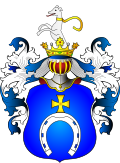| Koniecpolski | |
|---|---|
 | |
| Current region | Poland |
| Place of origin | Koniecpol, Poland |
| Connected families | Sobieski |
The House of Koniecpolski (plural: Koniecpolscy) is the name of an old and once powerful Polish noble family.
| Koniecpolski | |
|---|---|
 | |
| Current region | Poland |
| Place of origin | Koniecpol, Poland |
| Connected families | Sobieski |
The House of Koniecpolski (plural: Koniecpolscy) is the name of an old and once powerful Polish noble family.
The Koniecpolski was a magnate family. The family appears in the historical annals beginning in the 15th century. The family originated from the village Stary Koniecpol 40 km east of Częstochowa, currently in the Silesian Voivodeship. Their family name derives from that place's name. One of its first representatives was voivode of Sieradz Jakub Koniecpolski who participated in the Battle of Grunwald in 1410, considered the biggest battle in medieval history. In 1443 the Koniecpolski family founded the city-fortress Koniecpol, which became the seat of the family.
In the 16th century the family lineage split into two branches the "Hetman branch" and the "Castellan branch". In the 17th century the family acquired great political authority, and became owners of huge landed estates.
The most representative of the "Hetman branch" was Field and Grand Crown Hetman Stanisław Koniecpolski one of the greatest commanders of the 17th century. Stanislaw begun in 1643 the present-day construction of the Presidential Palace in Warsaw. He also ordered the reconstructing and strengthening of the Bar castle. Stanisław was owner of numerous latifundia situated in Poland's eastern borderlands. It was said that he owned so much landed property that he could cross the breadth of the Republic while spending every night in one of his own manors.
At the beginning of the 18th century, the family began to decline.


The Koniecpolski used the "Pobóg" arms.